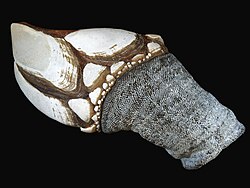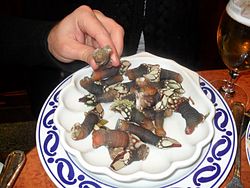Goose barnacle
 From Wikipedia - Reading time: 7 min
From Wikipedia - Reading time: 7 min
| Goose barnacle | |
|---|---|

| |
| Pollicipes pollicipes | |
| Scientific classification | |
| Kingdom: | Animalia |
| Phylum: | Arthropoda |
| Class: | Thecostraca |
| Subclass: | Cirripedia |
| Infraclass: | Thoracica |
| Order: | Pedunculata Lamarck, 1818 |
Goose barnacles, also called percebes, turtle-claw barnacles, stalked barnacles, gooseneck barnacles, are filter-feeding crustaceans that live attached to hard surfaces of rocks and flotsam in the ocean intertidal zone. Goose barnacles formerly made up the taxonomic order Pedunculata, but the group has been found to be polyphyletic, with its members scattered across multiple orders of the infraclass Thoracica.[1][2][3]
Biology
[edit]

Some species of goose barnacles such as Lepas anatifera are pelagic and are most frequently found on tidewrack on oceanic coasts. Unlike most other types of barnacles, intertidal goose barnacles (e.g. Pollicipes pollicipes and Pollicipes polymerus) depend on water motion rather than the movement of their cirri for feeding, so are found only on exposed or moderately exposed coasts.
Spontaneous generation
[edit]
In the days before birds were known to migrate, barnacle geese, Branta leucopsis, were thought to have developed from this crustacean through spontaneous generation, since they were never seen to nest in temperate Europe,[4] hence the English names "goose barnacle" and "barnacle goose", and the scientific name Lepas anserifera (Latin: anser, "goose"). The confusion was prompted by their similarities in colour and shape. Because they were often found on driftwood, the barnacles were assumed to be attached to branches before they fell in the water. The archdeacon of Brecon, Gerald of Wales, made this claim in his Topographia Hiberniae.[5]
Since barnacle geese were thought to be "neither flesh, nor born of flesh", they were allowed to be eaten on days when eating meat was forbidden by some Christian churches,[4] though it was not universally accepted. Holy Roman Emperor Frederick II examined barnacles and noted no evidence of any bird-like embryo in them, and the secretary of Lev of Rozmital wrote a very skeptical account of his reaction to being served the goose at a fast-day dinner in 1456.[6]
Biomedical research
[edit]One component of L. anatifera that continues to be researched today is the adhesive properties of its secretion. Following an observational study regarding the adhesive properties of goose barnacle, its adhesive gland cells were located inside the muscle layer on the back side of the main stalk (peduncle). These glands secrete protein-based adhesive to make attaching the barnacles to fixed or mobile entities possible. This research in the barnacle adhesive serves as inspiration to the healthcare community to conduct their own research in an attempt to improve medical adhesive.[7]
As food
[edit]
In Portugal and Spain, P. pollicipes is a widely consumed and expensive delicacy known as percebes, which are harvested commercially on the northern Iberian coast, mainly in Galicia and Asturias, and on the southwestern Portuguese coast (Alentejo), as well as imported from other countries within its range of distribution, particularly from Morocco. A larger but less palatable species (P. polymerus) was also exported to Spain from Canada until 1999, when the Canadian government ceased exports due to depletion of stocks.
In Spain, percebes are lightly boiled in brine and served whole and hot under a napkin. To eat them, the diamond-shaped foot is pinched between thumb and finger and the inner tube pulled out of the scaly case. The claw is removed and the remaining flesh is swallowed.[8] Historically, the indigenous peoples of California ate the stem after cooking it in hot ashes.[9]
References
[edit]- ^ Chan, Benny K. K.; Dreyer, Niklas; Gale, Andy S.; Glenner, Henrik; et al. (2021). "The evolutionary diversity of barnacles, with an updated classification of fossil and living forms". Zoological Journal of the Linnean Society. 193 (3): 789–846. doi:10.1093/zoolinnean/zlaa160. hdl:11250/2990967.
- ^ Buckeridge, John; Newman, William (2006). "A revision of the Iblidae and the stalked barnacles (Crustacea: Cirripedia: Thoracica), including new ordinal, familial and generic taxa, and two new species from New Zealand and Tasmanian waters". Zootaxa. 1136: 1. doi:10.11646/zootaxa.1136.1.1.
- ^ "World Register of Marine Species, Thoracica". marinespecies.org. Retrieved 2021-08-26.
- ^ a b Michael Allaby (2009). "Barnacles". Animals: from Mythology to Zoology. Infobase Publishing. pp. 75–77. ISBN 978-0-8160-6101-3.
- ^ Beatrice White (1945). "Whale-hunting, the barnacle goose, and the date of the "Ancrene Riwle". Three notes on Old and Middle English". The Modern Language Review. 40 (3): 205–207. doi:10.2307/3716844. JSTOR 3716844.
- ^ Henisch, Bridget Ann, Fast and Feast: Food in Medieval Society. The Pennsylvania State Press, University Park. 1976. ISBN 0-271-01230-7, pp. 48–49.
- ^ Gan, Kesheng; Liang, Chao; Bi, Xiangyun; Wu, Jizhe; Ye, Zonghuang; Wu, Wenjian; Hu, Biru (2022-04-25). "Adhesive Materials Inspired by Barnacle Underwater Adhesion: Biological Principles and Biomimetic Designs". Frontiers in Bioengineering and Biotechnology. 10. doi:10.3389/fbioe.2022.870445. ISSN 2296-4185. PMC 9097139. PMID 35573228.
- ^ "Percebes: Grail trail". The Daily Telegraph. 23 April 2004. Retrieved 2024-04-07.
- ^ The Natural World of the California Indians. By Robert F. Heizer and Albert B. Elsasser. Via books.google.com, Accessed 2024-04-07
 KSF
KSF